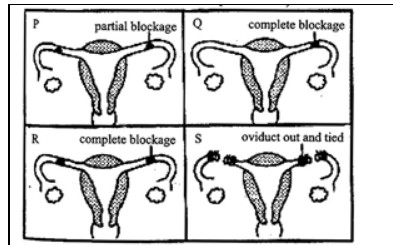
The accompanying diagram shows the uterine tubes of four women (P, Q, R and S)

In which of two women, fertilisation is impossible at present?
A. P and Q
B. Q and R
C. R and S
D. S and P

Answer
363k+ views
Hint:For the process of fertilisation, it is important for the egg and sperm to have a contact This would not be possible if the egg does not reach the uterus. Therefore, for this process to occur, the path should be clear for the ovule to reach the uterus without any obstruction.
Complete Step by Step Answer:
In the figure P, it is shown that there is partial blockage in the fallopian tubes. Thus, there is a probability that the ovule released from the ovary will reach the uterus. Thus, there are chances of fertilisation.
In the figure Q, we see a complete blockage of the fallopian tube from one side while the other fallopian tube provides no obstruction. Therefore, again fertilisation is possible due to the concept explained above.
In the figure R, there is complete blockage of fallopian tubes. This rules out any chance of fertilisation.
In the figure S, both the fallopian tubes are ligated. This too would not allow fertilisation as the carrier path has blocked.
Thus, we conclude that the correct answer is C: R and S
Note: In the figure S, the process that is shown is called Tubectomy. This is a surgical procedure that involves cutting and tying the fallopian tubes to prevent the entry of ovules in the uterus. Vasectomy on the contrary involves the process of ligation of vas deferens. This prevents the entry of sperm into semen. Both procedures are efficient contraceptive methods but have a poor reversibility rate.
Complete Step by Step Answer:
In the figure P, it is shown that there is partial blockage in the fallopian tubes. Thus, there is a probability that the ovule released from the ovary will reach the uterus. Thus, there are chances of fertilisation.
In the figure Q, we see a complete blockage of the fallopian tube from one side while the other fallopian tube provides no obstruction. Therefore, again fertilisation is possible due to the concept explained above.
In the figure R, there is complete blockage of fallopian tubes. This rules out any chance of fertilisation.
In the figure S, both the fallopian tubes are ligated. This too would not allow fertilisation as the carrier path has blocked.
Thus, we conclude that the correct answer is C: R and S
Note: In the figure S, the process that is shown is called Tubectomy. This is a surgical procedure that involves cutting and tying the fallopian tubes to prevent the entry of ovules in the uterus. Vasectomy on the contrary involves the process of ligation of vas deferens. This prevents the entry of sperm into semen. Both procedures are efficient contraceptive methods but have a poor reversibility rate.
Recently Updated Pages
Capping is a process in which A adenylate is added class 12 biology NEET_UG

Explain in brief the separation and isolation of DNA class 12 biology NEET_UG

Number of testicular lobules in testes is A 250 B 500 class 12 biology NEET_UG

The number of solutions in x in 02pi for which sqrt class 12 maths CBSE

Write any two methods of preparation of phenol Give class 12 chemistry CBSE

Differentiate between action potential and resting class 12 biology CBSE

Trending doubts
What is BLO What is the full form of BLO class 8 social science CBSE

Which are the Top 10 Largest Countries of the World?

Fill the blanks with the suitable prepositions 1 The class 9 english CBSE

Why is there a time difference of about 5 hours between class 10 social science CBSE

One Metric ton is equal to kg A 10000 B 1000 C 100 class 11 physics CBSE

What are the major means of transport Explain each class 12 social science CBSE




